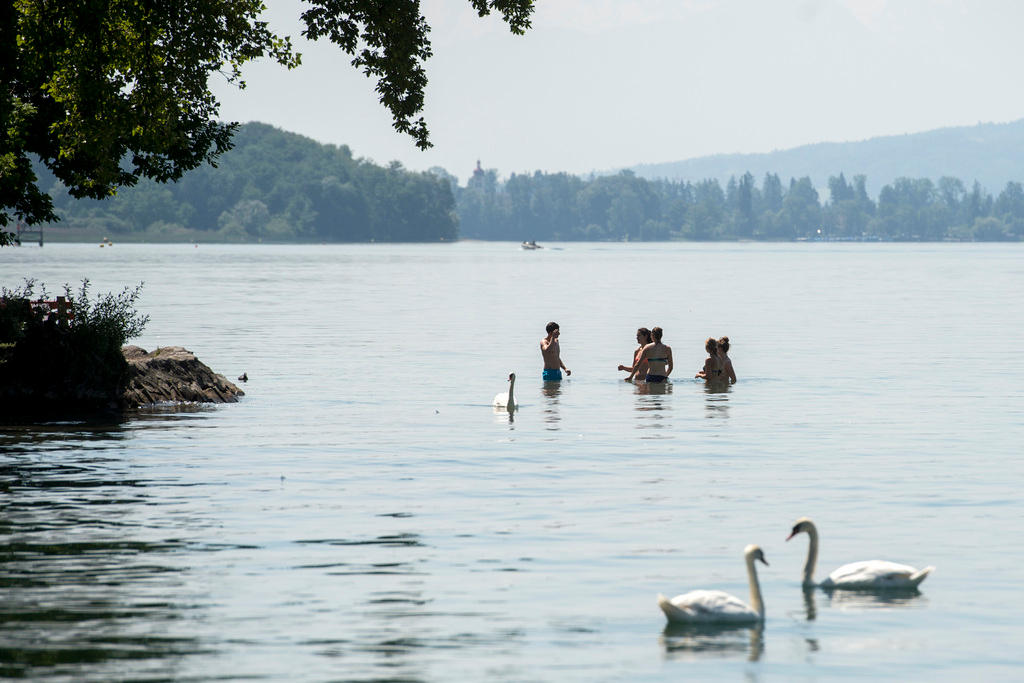
Lakes could be significant producers of methane

Lakes and freshwater systems account for over 20% of all methane emissions into the atmosphere – much more than previously estimated, according to scientists at the University of Geneva (UNIGE).
Until recently, it had been thought that methane could only be produced in oxygen-deprived environments, such as the sedimentary layers found at the bottom of lakes. In reality, surface water, even though it is mixed by the wind and rich in oxygen, produces a significant amount of methane, the group of researchers has revealed.
This phenomenon, which is still largely unknown, has been highlighted by a two-year field study designed to measure the methane concentration and production in the surface water (the top five metres) of Lake Hallwil in canton Aargau.
The UNIGE research, which is published in Nature CommunicationsExternal link, shows that lakes play a critical role in the methane gas cycle, where the greenhouse effect is 28 times higher than for carbon dioxide.
The measurement campaign was conducted over the summers of 2015 and 2016 in Lake Hallwil, with an unexpected conclusion: the mechanical accumulation of methane in the lake surface cannot explain the concentrations that the scientists observed.
The mixing of the surface water creates a continuous, one-way exchange with the atmosphere, and the methane escapes from the water into the air. The concentration should, therefore, be much lower, and the rates observed can only be explained by the fact that the gas is being produced in the surface layer.

More
Kangaroo-like cows could reduce methane emissions
“Something huge is going on in the surface water, and nobody has been paying attention to it so far,” said study co-author Daniel McGinnis. A similar phenomenon has been reported in the surface of the oceans but on a smaller scale, about 1,000 times lower. In short, though there is less area covered by freshwater than oceans, the contribution from lakes is the same.
Methane, lakes and cows
Ninety per cent of methane emissions from Lake Hallwil – about 25 tons a year – are thought to be produced in the top five metres of the water column, and the research results suggest that the same phenomenon occurs in other lakes with similar characteristics.
Although most of the methane formed in the sediment disappears through oxidation as it rises in the lake water, the same is not true for the methane generated near the surface: this escapes directly into the atmosphere. The scientists say it is therefore possible that lakes could be enormous producers of methane – much larger producers, in fact, than previously estimated.
Cattle flatulence is a major source of methane gas. Since it was first documented, bovine flatulence has been used as an informal measure of methane emissions, and the UNIGE researchers invited the comparison: Lake Hallwil, with a surface area of about ten square kilometres, generates as much methane every year as a herd of 240 cows.
The UNIGE researchers cite the possible role of algae as one hypothesis to explain the production of methane close to the lake’s surface. They also mention the potential presence of anaerobic niches, oxygen-deprived environments that might act as “methane incubators”.
Another hypothesis is that the bacteria that take part in the methane oxidation process are inhibited by light, and their action would, therefore, be non-existent near the surface.
“The methane produced in lake surface water is probably the result of several factors, and may not even be produced by bacteria. It could be the by-product of another, yet unknown process,” McGinnis said.

In compliance with the JTI standards
More: SWI swissinfo.ch certified by the Journalism Trust Initiative

















![The four-metre-long painting "Sonntag der Bergbauern" [Sunday of the Mountain Farmers, 1923-24/26] had to be removed by a crane from the German Chancellery in Berlin for the exhibition in Bern.](https://www.swissinfo.ch/content/wp-content/uploads/sites/13/2025/12/01_Pressebild_KirchnerxKirchner.jpg?ver=8f77363a)











You can find an overview of ongoing debates with our journalists here . Please join us!
If you want to start a conversation about a topic raised in this article or want to report factual errors, email us at english@swissinfo.ch.